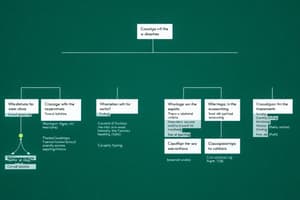Podcast
Questions and Answers
What role do leaves play in a decision tree for classification?
What role do leaves play in a decision tree for classification?
- They represent different features of the data.
- They serve as branches connecting the nodes.
- They signify the possible outcomes or classes. (correct)
- They indicate the decisions made at each node.
Which algorithm is specifically used for constructing regression trees?
Which algorithm is specifically used for constructing regression trees?
- CART (correct)
- C4.5
- CHAID
- ID3
What is the purpose of pruning a decision tree?
What is the purpose of pruning a decision tree?
- To create more branches for higher accuracy.
- To increase the complexity of the model.
- To ensure each node has enough data points.
- To remove unnecessary branches and reduce overfitting. (correct)
Which method is NOT a feature selection technique?
Which method is NOT a feature selection technique?
How does overfitting affect model performance?
How does overfitting affect model performance?
What does Gini Impurity measure in the context of decision trees?
What does Gini Impurity measure in the context of decision trees?
Which pruning method grows the tree fully before removal of branches?
Which pruning method grows the tree fully before removal of branches?
Entropy is used as a splitting criterion in decision trees to measure what?
Entropy is used as a splitting criterion in decision trees to measure what?
Study Notes
Decision Trees
Classification Techniques
- Definition: Decision trees for classification are used to predict categorical outcomes.
- Structure: Consists of nodes (features), branches (decisions), and leaves (outcomes).
- Algorithm: Common algorithms include:
- ID3 (Iterative Dichotomiser 3)
- C4.5 (extends ID3 with continuous attributes)
- CART (Classification and Regression Trees)
- Splitting Criteria:
- Gini Impurity: Measures impurity in a dataset.
- Entropy: Measures the information gain.
- Chi-square: Tests independence between categorical variables.
Regression Trees
- Purpose: Used to predict continuous outcomes rather than categorical.
- Structure: Similar to classification trees, but leaves represent average values instead of classes.
- Algorithm: Typically uses CART for constructing regression trees.
- Splitting Criteria:
- Mean Squared Error (MSE): Minimizes the variance within each partition.
Pruning Methods
- Definition: Process of removing parts of the tree that do not provide power to classify instances.
- Types:
- Pre-pruning: Stops the tree from growing beyond a certain point (maximum depth, minimum samples per leaf).
- Post-pruning: Grows the tree fully and then removes branches that have little importance based on validation data.
- Benefits:
- Reduces overfitting.
- Improves model generalization to unseen data.
Feature Selection
- Importance: Selecting relevant features can improve model performance and interpretability.
- Methods:
- Recursive Feature Elimination: Iteratively removes less important features.
- Information Gain: Selects features that provide the most information about the target variable.
- Chi-square Test: Evaluates relationships between categorical features and the target variable.
Overfitting Avoidance
- Definition: Overfitting occurs when a model learns noise in the training data, leading to poor generalization.
- Strategies:
- Pruning: As mentioned, reduces complexity of the model.
- Setting a maximum tree depth: Limits the size of the tree.
- Using a validation set: Helps assess the model's performance on unseen data.
- Ensemble Methods: Techniques like Random Forests combine multiple trees to improve robustness and reduce overfitting.
Classification Techniques
- Decision trees predict categorical outcomes through a hierarchical structure of nodes, branches, and leaves.
- Key algorithms:
- ID3: Utilizes entropy to determine splits.
- C4.5: Enhances ID3 to handle continuous attributes.
- CART: Applies to both classification and regression tasks.
- Splitting criteria for decision-making include:
- Gini Impurity: Evaluates dataset impurity.
- Entropy: Assesses information gain.
- Chi-square: Tests relationships between categorical variables.
Regression Trees
- Aimed at predicting continuous outcomes, with leaves giving average values instead of class labels.
- CART is primarily utilized for constructing regression trees.
- Mean Squared Error (MSE) is employed as the splitting criterion to minimize within-group variance.
Pruning Methods
- Pruning refines the decision tree by removing ineffective branches, enhancing model efficiency.
- Pre-pruning prevents tree growth beyond set thresholds like maximum depth or minimum samples per leaf.
- Post-pruning allows full tree growth before trimming less significant branches based on validation data.
- Benefits include reducing overfitting and improving generalization on new data.
Feature Selection
- Selecting pertinent features is crucial for enhancing model performance and interpretability.
- Techniques for feature selection:
- Recursive Feature Elimination: Gradually discards insignificant features.
- Information Gain: Chooses features that yield maximum information about the target variable.
- Chi-square Test: Assesses the strength of relationships between categorical predictors and the target.
Overfitting Avoidance
- Overfitting happens when a model captures noise in training data, impairing generalization.
- Strategies to mitigate overfitting include:
- Pruning: Simplifies the model by cutting unnecessary parts.
- Setting a maximum tree depth: Regulates tree complexity.
- Using a validation set: Evaluates model performance on unseen data.
- Ensemble Methods: Techniques like Random Forests harness multiple trees to bolster predictability and reduce overfitting risks.
Studying That Suits You
Use AI to generate personalized quizzes and flashcards to suit your learning preferences.
Description
This quiz explores the concepts of decision trees used for both classification and regression tasks. It covers algorithms such as ID3, C4.5, and CART, along with splitting criteria like Gini Impurity, Entropy, and Mean Squared Error. Test your understanding of how decision trees work and their applications in data analysis.



